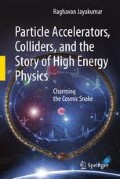Abstract
When boys play with toy trains and imagine spectacular collisions, they first dash them into walls. When they get other boys to bring their trains, they dash their trains into those others, to imagine even more spectacular collisions. Physicists know the benefit of these collisions and have learnt to exploit them. The way to think of a high-energy particle collision is that when an energetic particle hits another oncoming high-energy particle or a target (a solid, liquid, or gas consisting of other particles with very small energies), the identity of the colliding particles is lost and a soup of matter and energy is created. Then, new particles are born from this soup with various probabilities, while conserving certain basic parameters that went into the collisions. In earlier accelerators, the particles were only smashed into stationary targets and the accuracy of the beam targeting was not an issue. But, in such a scheme, the incident particle and the new particles carry away considerable energy after the collision, without using all the incident energy to create the new particles. This is similar to a ball thrown against a wall; the ball does not leave much energy behind at the wall as it bounces back. This is because the net momentum of the particle has to be conserved and the incident particle and any new particle, created in the collision, have to carry this momentum. The energy available for the new reaction or new particle creation is then only what is left after supplying the kinetic energy of the outgoing particles.
Access this chapter
Tax calculation will be finalised at checkout
Purchases are for personal use only
Author information
Authors and Affiliations
Corresponding author
Rights and permissions
Copyright information
© 2012 Springer-Verlag Berlin Heidelberg
About this chapter
Cite this chapter
Jayakumar, R. (2012). Collision Course. In: Particle Accelerators, Colliders, and the Story of High Energy Physics. Springer, Berlin, Heidelberg. https://doi.org/10.1007/978-3-642-22064-7_11
Download citation
DOI: https://doi.org/10.1007/978-3-642-22064-7_11
Published:
Publisher Name: Springer, Berlin, Heidelberg
Print ISBN: 978-3-642-22063-0
Online ISBN: 978-3-642-22064-7
eBook Packages: Physics and AstronomyPhysics and Astronomy (R0)

